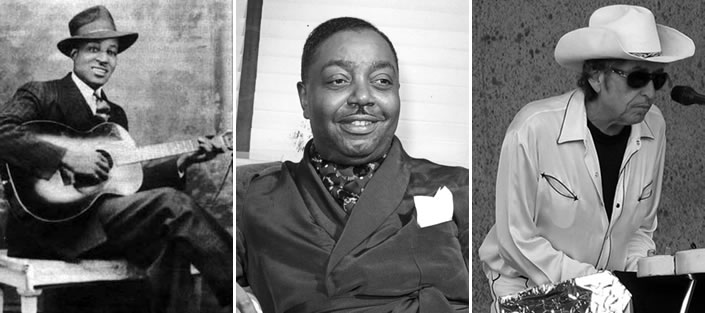Allegro
Black Roots
The African-American influence on folk music
Volume CX, No. 2February, 2010

Big Bill Broonzy (top left) helped bring the blues into larger, urban audiences in the 1950’s. Big Joe Turner (top right) recorded “Shake, Rattle and Roll” in 1954. Bob Dylan (right) was undeniably influenced by black blues and gospel. Public domain photos via the internet.
Studs Terkel once asked Big Bill Broonzy after he heard him sing a song, “Is that a folk song?” Broonzy’s reply was, “I ain’t heard no horses sing it.”
Broonzy was one of our most influential blues musicians and helped move blues into large, urban audiences in the 1950’s, just when he was about to give up the music business altogether.
February is Black History Month, and it’s impossible to imagine folk music – and indeed, popular music – in America without the African contribution.
The main trunks of popular music – jazz, country and rock – all have their roots deep in African American music. Folk music, the orphan cousin of the above and difficultly defined, also remains without question beholden to African American folkways.
Let’s start with what is popularly known as country music.
Jimmy Rodgers, known widely as the father of country music, invented his blues style – complete with accompanying yodel – from the cloth of early black railroad songs and black vaudeville singers. (Hank Williams, the first unqualified country star, owes an undeniable debt to him.)
Equally influential on the linear journey of country music was the Carter Family, who made their first record in the same year and place that Jimmy Rodgers did in 1927. The Carters’ wide repertoire included songs from Irish and Scottish distillations of the Southern Appalachian hills, but just as strongly from African American blues.
Rock music (and its cousin, soul music) began crowding out popular jazz as the chart-busters of recorded music in the 1950’s. The first rock artists were arguably black. Elvis was dubbed the King of Rock and Roll, but he stole his crown from such African American rockers as Little Richard, Fats Domino and Chuck Berry.
This new sound was influenced greatly by black blues artists. In fact, one of the first rock songs, “Shake, Rattle and Roll,” was performed by the bluesman Joe Turner. One of the greatest cultural travesties in America was the racist cooption and theft of this music by white performers and their record companies.
The contemporary perception of what is carelessly called “folk music” actually came from the folk revival of the 40’s and 50’s, as well as the great “folk scare” of the 60’s, when so-called folk artists made their imprint on major record labels, beginning with Bob Dylan (preceded by a few early-warnings from Harry Belafonte, the Weavers and the Kingston Trio.)
Dylan was the first to take a traditional mimicking and turn it into an urban original song movement. His songs and those of his peers owe an undeniable debt to black blues and gospel.
The civil rights movement made its own mark on folk music when countless gospel and blues songs were transformed into the fight songs of that movement. (Think of “Ain’t Gonna Let Nobody Turn Me ‘Round” and “Keep Your Eyes on the Prize.”)
In Memphis a few years back, some of us latter-day folkies
organized a tour of the Civil Rights Museum in the old Lorraine Motel where Dr. King was killed. As we stood in line waiting to purchase tickets, some of us struck up some civil rights songs. A group of African American high school students stood near us and moved closer to listen to the words we were singing, clearly unfamiliar with the songs. We were, for the most part, white.
The tremendous irony of the moment was not lost on any of us. Before we entered the museum on that brisk February day, the students and we were singing the songs together – songs that we had gotten from their grandparents. A circle was complete.
John O’Connor, the union’s recording vice president, is also a widely known and recorded folk singer and songwriter.
